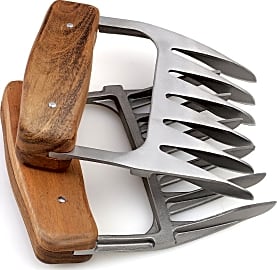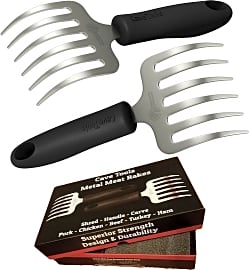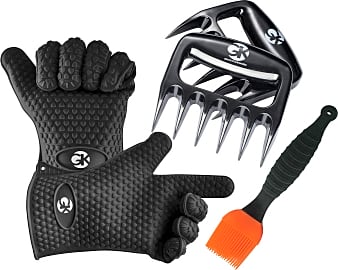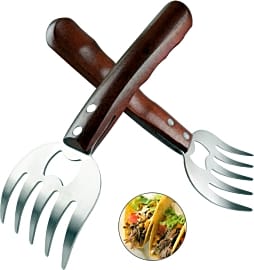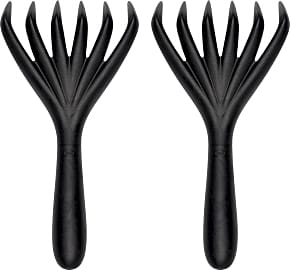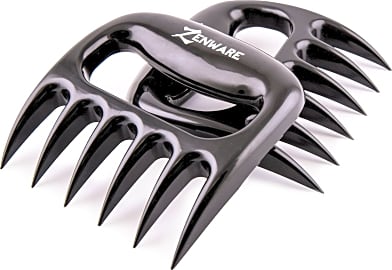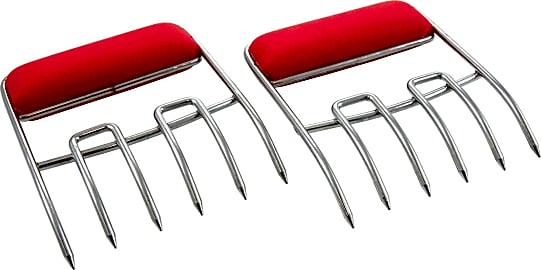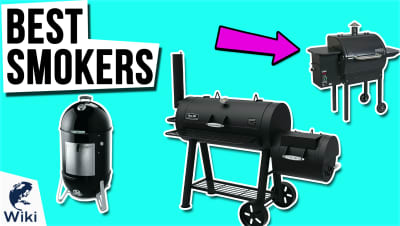The 10 Best BBQ Claws

This wiki has been updated 35 times since it was first published in April of 2016. BBQ claws make the work of pulling pork, beef, and poultry safe and easy. These time-saving shredders protect your hands from the heat of freshly-cooked cuts and a sizzling grill, while creating a texture that goes perfectly in a hamburger bun. Conveniently, many models can also be used to handle and transport all sorts of piping hot food and keep hard-to-hold items steady while you slice them. When users buy our independently chosen editorial selections, we may earn commissions to help fund the Wiki.
Editor's Notes
April 21, 2020:
Many home cooks know how versatile shredded meat is for a host of recipes, from pulled pork sandwiches to chicken soft tacos, but if you've ever used two forks to get the job done you know how laborious it can be. BBQ claws offer a quick, easy, and fun way to do twice the work in half the time, but you'll need to consider their construction, dimensions, and style to ensure you purchase the right set.
If you frequently find yourself removing thick, heavy cuts of meat from a smoker, crockpot, or pressure cooker, then you'll want a pair that has long handles to keep your hands away from heat. Selections like the Oxo Good Grips Tailgating are good here. These elongated styles are capable of getting a good grip so you don't drop your meat, but some people find they need a bit of practice handling them before they feel confident transporting food. Another plus of this design is their generous size, which makes them ideal for shredding large portions.
On the flip side, if you're often working with small cuts or processing an average quantity of food, say, for a family dinner, then you'll need something a bit more compact, like the Zenware Pork Shredders. This set is crafted of nylon, as are the Original Bear Paws, while the newly-added Grillaholics Ultra-Sharp are lightweight, yet strong, plastic. The Charcoal Companion and 1Easylife Metal are rugged stainless steel. All of these materials have exceptional heat resistance, however stainless steel can withstand much higher temperatures and will not warp or melt.
Today's update saw the removal of a few selections due to availability and other issues. We scrapped the Ablest Meat Handlers, which saw a design change that wasn't for the better and the Wuudi Shredders, a set that's similar, yet inferior to the 1Easylife Metal. We decided that the Cave Tools Meat Forks, although a nice pair, could stand to be swapped out for the Cave Tools Rakes, a selection from the same brand with a more versatile design. We also added the Aiyue Serving, an attractive choice with strong, riveted wooden handles that are appropriate for serving guests at dinner parties, and the Barbuzzo Raptor Rippers for dinosaur lovers and folks who want to involve their kids more in the kitchen.
Special Honors
Vollrath 403N Redco BBQ claws are ideal for family dinners and backyard potlucks, but if you're consistently preparing large batches of pulled pork or similar dishes, then you'll need something that can churn out higher quantities with less effort. The Vollrath 403N Redco is a restaurant-quality, pusher-style shredder capable of high-volume output. It's outfitted with 28 sharp, thin blades designed to cut without browning or bruising ingredients and can make quick work of soft, cooked meats and a wide variety of fruits and vegetables, including lettuce, cantaloupes, cucumbers, and bell peppers. webstaurantstore.com
Which Claws Are Best For You?
These can endure plenty of abuse and scalding conditions without warping, not to mention they're meant to last for years.
BBQ claws come in a handful of shapes and materials. When weighing your options, your main concerns should be durability and efficiency. After that, it’s good to consider how you’ll be holding them and what other uses you may put them to. As you mull over our list, you’ll want to take a few things into account to ensure you’re getting the best product for your personal needs.
Claws need to be made with tough materials that can handle high temperatures. Some of the best heat-resistant options use stainless steel. These can endure plenty of abuse and scalding conditions without warping, not to mention they're meant to last for years. You'll have to take care though, as stainless steel can easily scratch up your pots and pans.
Another popular material is nylon, which has the capacity to withstand temperatures of up to 475 degrees. When eyeing products constructed from nylon or polycarbonate plastics, be sure to double-check that they're food-grade and BPA-free.
It’s also smart to consider which setup feels most at home in your hands and provides you with the best grip. The most popular style consists of a curved handle that you wrap your fingers underneath, leaving the sharp points to take their place. These are very intuitive to use and can give you an excellent angle for lifting, shredding, and holding an item steady while you slice it.
If you don’t like wielding something that brushes against your knuckles or you're simply used to the old-school twin fork approach, opt for a long-handled selection instead. These are helpful for keeping your mitts at a distance from hot pans, but be careful to grasp them tightly when transporting heavier delectables like whole chickens.
After a successful backyard get-together or delicious family dinner, the last thing you want to worry about is the cleanup. A set of claws that are easy to rinse and dishwasher-safe will save you precious time that could be spent on more important things, like recuperating on the couch.
The Birth Of Barbecue
When you think of things that are distinctly American, barbecue always makes the shortlist. But just like apple pie, democracy, and countless other Yankee staples, barbecue actually originated outside our shores. What’s more, its development in the United States was heavily influenced by European immigrants and various cultures. The result is a vibrant subset of cuisine filled with mouthwatering meats, delicious sides, and a litany of fiercely-defended traditions.
Texans considered beef a suitable meat for barbecuing, while for the residents of certain southern states, only pork would do.
When Christopher Columbus came into contact with the indigenous people of Hispaniola, he noted that they had a peculiar method of preparing meat — they roasted it for hours by leaving it on a framework of wooden sticks that rested above an open fire. The low heat and smoke gave it a distinctive flavor, and the Spanish allegedly began referring to the process as barbacoa.
As Spanish conquistadors continued their expeditions north to Florida and other parts of what would eventually become the United States, they took Caribbean cooking customs with them. Barbacoa spread throughout the colonies and developed differently in each region.
Prior to the Civil War, settlers in southern communities ate pork in large quantities, as cows were expensive to feed and required more land. People would routinely gather for slaughtering parties called pig pickin’s, where they would roast and devour hogs.
Over the years, various traditions crept through the American South and beyond. In South Carolina, French and German immigrants were partial to mustard-based sauces, while colonists in North Carolina preferred a vinegar base, which was in line with British tastes. Texans considered beef a suitable meat for barbecuing, while for the residents of certain southern states, only pork would do.
These days, there are countless main courses, sauces, and sides to satiate any craving. Barbecue has grown to become an American staple that brings people together to savor the incredible taste of meat smoked to perfection.
Tips For Throwing A Backyard Barbecue
If you’re in the market for a fresh set of BBQ claws, then chances are you’ve got a backyard barbecue planned in the near future. While we can all learn from trial and error, you can make things much easier on yourself by heeding a few of the following tips.
Start by preparing as much food as you can beforehand. Plan your menu well in advance and make an ingredient list — this way grocery shopping will be a breeze. Get going on your meats a few hours before anyone shows up, then get to work on your side dishes. Have your lettuce, tomatoes, onions, and everything else chopped and ready to go, and have your snacks and drinks organized.
If your guests are bringing their little ones along, have a separate tub for their beverages, as well.
When setting up your snack table, be sure to place it well away from your grill or smoker. This will give whoever is cooking ample space to move around, plus it will keep partygoers safely removed from sources of heat. Complement your edibles with plenty of drinks, including water, sodas, and beer. If your guests are bringing their little ones along, have a separate tub for their beverages, as well.
Feel free to give your guests the opportunity to bring along their own side dishes if they'd like. Not only does this enliven your menu and take some of the pressure off of you, it creates a communal atmosphere and enables your friends to show off their cooking talents, too.
Set the mood. String lights or tiki torches can create a wonderfully warm ambiance, and are an excellent way to keep the party going into the night. Many solar options are capable of automatically switching on at dusk, so you can rely on them to seamlessly transition you and your guests into the evening. Odds are that your friends and family will want to listen to their favorite tunes, so consider investing in a quality outdoor speaker with bluetooth compatibility.
Don’t forget to make trash cans readily accessible. Include options for recyclables, and mark them clearly so your visitors can tell the difference. Cleaning up your outdoor space will be much simpler for it, and it will eliminate the need for people to constantly shuffle in and out of your home.



